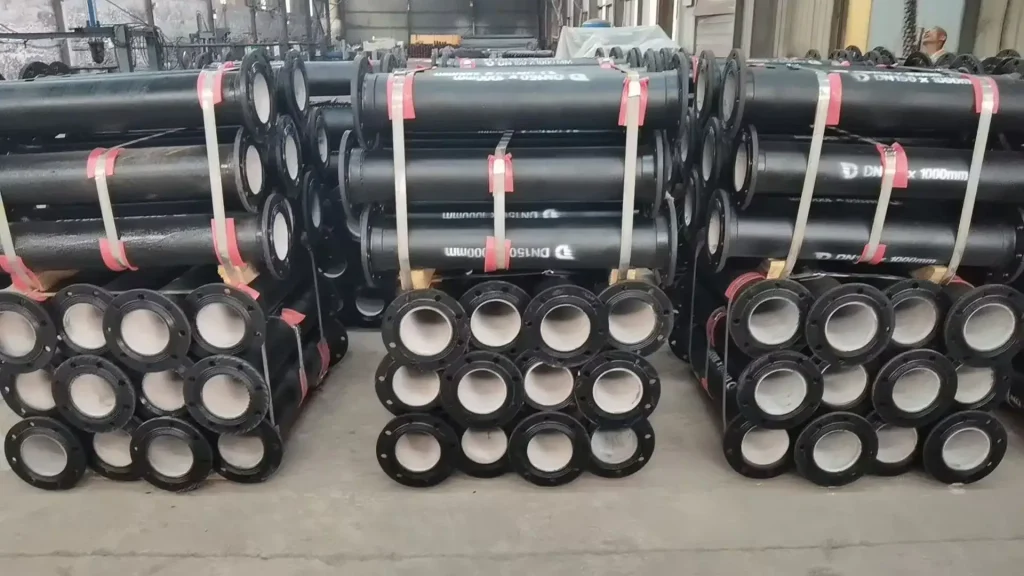Ductile iron – also known as nodular cast iron or spheroidal graphite iron – is produced by adding nodulizing agents (usually magnesium or cerium-based alloys) to molten cast iron. This treatment converts the graphite from flakes (as in gray cast iron) into spherical nodules. The resulting structure delivers dramatically improved ductility, toughness, and strength while retaining excellent castability and machinability.

Ductile iron is typically classified not by a single “grade” but by several attributes including:
-
Mechanical Properties: Tensile strength, yield strength, elongation, and hardness.
-
Material Composition: Relative amounts of carbon, silicon, manganese, phosphorus, sulfur, and trace alloying elements.
-
Microstructure: Degree of nodularity, which can be graded according to the nodule count or nodule shape factors.
-
Surface Treatments & Lining Options: Internal coatings (such as cement mortar lining) and external protective coatings.
Common Grades of Ductile Iron
In practice, ductile iron is most often categorized based on its mechanical properties and the industry standards it meets. Several widely recognized grades include:
1. GGG40 Grade
-
Overview: This grade is among the lower-strength ductile iron types. It offers moderate tensile and yield strength and is often used for water piping and low-pressure applications.
-
Mechanical Properties:
-
Tensile strength generally around 380–420 MPa
-
Yield strength slightly lower, with moderate elongation (around 10–12%)
-
-
Applications: Ideal for drainage systems, low-pressure water distribution, and non-critical infrastructure components.
2. GGG50 Grade
-
Overview: The most commonly used grade in ductile iron pipe manufacturing, GGG50 is designed to offer high strength and toughness while retaining excellent ductility.
-
Mechanical Properties:
-
Minimum tensile strength: Approximately 420 MPa or higher.
-
Yield strength: Approximately 300 MPa or more.
-
Elongation: At least 10%.
-
Hardness: Typically maintained at or below 230 HB.
-
-
Applications: Widely adopted in municipal water mains, sewer systems, high-pressure force mains, and many industrial pipeline systems.
-
Significance: Many international standards (ISO 2531, EN 545, EN 598) reference GGG50 for ductile iron pipes, making it a trusted material in critical infrastructure.
3. Higher-Strength Variants (e.g., GGG55, GGG60)
-
Overview: In some applications, especially when higher mechanical performance is required, manufacturers may produce ductile iron with higher strength levels (often designated as GGG55, GGG60, etc.).
-
Mechanical Properties:
-
Increased tensile and yield strengths to meet more demanding engineering requirements.
-
May exhibit slightly reduced elongation compared to GGG50, but the trade-off is enhanced load-bearing capacity.
-
-
Applications: Suitable for extremely high-pressure systems, industrial applications, and situations where higher impact resistance is mandatory.
-
Considerations: These higher-strength grades are less common than GGG50 and typically have higher manufacturing costs. They are used in specialized projects where improved performance justifies the cost.
4. Classifications Based on Pressure and Wall Thickness
In addition to the base grade (e.g., GGG50), ductile iron pipes are also classified into pressure classes using designations such as K7, K8, K9 or C25, C30, C40. While these classifications primarily indicate the wall thickness and pressure rating rather than a change in the iron’s composition, they are closely related to the base iron grade:
-
K-Class (K7, K8, K9): These denote ductile iron pipes where the design is based on the pipe’s wall thickness. For instance, the K9 designation (when produced using GGG50 material) represents a pipe with the highest wall thickness and pressure capability within the K series.
-
C-Class (C25, C30, C40): These classifications refer to pipes designed based on allowable working pressure. Although they are not fundamental changes in the ductile iron material grade, they are integral to how the material is applied in different conditions.
Standards and Testing
Ductile iron grades are specified by international standards that define the required mechanical properties, dimensional tolerances, and quality control measures. Key standards include:
-
ISO 2531: Specifies dimensions, tolerances, mechanical properties, and test methods for ductile iron pipes.
-
EN 545 and EN 598: European standards that cover the requirements for ductile iron pipes and their joints for potable water and sewage applications, respectively.
-
ASTM Standards: In the United States, similar requirements may be found in ASTM standards, though ductile iron piping is more often referenced by ISO or EN standards in international markets.
Compliance with these standards ensures that the ductile iron used in pipe applications meets the necessary criteria for durability, pressure rating, and structural integrity.
The grading of ductile iron is primarily determined by its mechanical performance and adherence to industry standards. The most commonly used grade in ductile iron pipes is GGG50, which balances high strength, ductility, and durability, making it ideal for a wide range of applications—from municipal water systems to high-pressure industrial pipelines. In some cases, higher-strength variants (such as GGG55 or GGG60) are used to meet more demanding conditions. Additionally, classifications such as the K (K7, K8, K9) and C (C25, C30, C40) series indicate design variations focused on wall thickness and pressure capacity, expanding the utility of the base material grade.
References:
- Ductile Iron – Wikipedia
- ISO 2531: Ductile iron pipes, fittings, accessories and their joints for water pipelines — Requirements and test methods – ISO
- EN 545: Ductile iron pipes, fittings, accessories and their joints for water pipelines — Requirements and test methods – CEN
- ASTM A536 – Standard Specification for Ductile Iron Castings – ASTM International
- Ductile Iron: Properties and Applications – ScienceDirect Topics

